Main Menu
Twisted Branch Trail Run: Take 2

Kuwanna has a PhD in geology and is a UESCA-certified Ultra Run Coach. She is married with two daughters and feels that running all the miles is a great panacea for helping navigate those teenage years. Kuwanna has a love for tough, vertical trail marathons and ultras, with several Beast Coast races under her belt, including Virgil Crest, Cayuga Trails, Hyner View Trail Challenge, and Breakneck Point Trail Runs. Having now completed several 50Ks, 50-milers, and a 100K, she’s eyeing her first 100-miler. When Kuwanna’s not running on the trails, she’s writing about it. She is co-editor/writer at the Trails Collective and has created content for the Patagonia Trail Running IG. She also serves on the Finger Lakes Runner’s Club Communications Team. Instagram handle is @dyerpietras.
Share This Article!
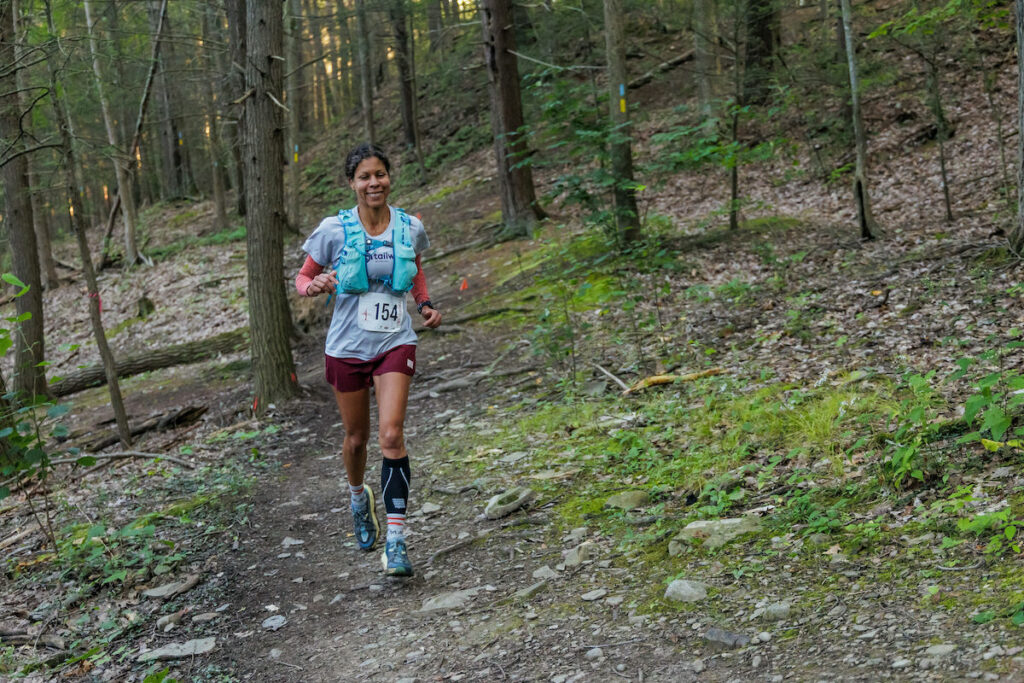
The Flashback: I was only 20 miles from the Urbana aid station, and in my own mind, I was in the home stretch. After refilling my soft flasks, I would be ready to run.
Yet there I was, standing at Bud Valley, watching the aid station volunteers take down the canopies and pack up the water and snacks.
It was all very surreal and dreamlike. Perhaps going from full throttle to a complete stop in an instant will do that. Watching the aid station captain sprint toward you as you sprint toward him, his arm extended and hand up, will also do that.
“I’m sorry, but you’re past the cutoff and we can’t allow you to continue!”
I paused my Garmin but could not bring myself to end the workout. I would keep it on pause just in case they might change their mind. But rules are rules, and in the end, I waited so long that my Garmin ended the workout for me.
40.77 miles and 6,735 ft of elevation gain.
The Aftermath: I learned that it takes a few days to process a DNF. I would spend the remainder of that weekend in a state of suspended animation, trapped in that singular moment of being informed I could no longer continue. Memories of spectators assuring me I was still a winner as I approached Bud Valley flooded my mind. Clearly they had already known what I was about to discover.
But in the coming days the fog gradually lifted, and I no longer felt trapped in that painful moment of being informed I could no longer continue. Time had passed and all the other race participants had moved on. I was finally able to move on too.
In the weeks that followed, I’d look back with greater clarity and recognize how my race began unraveling from the moment I started running. I never seemed to have as much run in my legs as I was accustomed to (I’d find out later I was glutened), and this was ever more apparent this past weekend when I would reach Bud Valley almost 2.5 hours earlier than I did last year. I also began the 2022 race with a tension headache, did not taper in all areas of my life (my parents’ estate sale coincided with race month), arrived to the race much too nervous, ate too much watermelon (I bloated), did not apply the right race strategy (started much too conservatively for the first half of the race, which is when you need to be a little more aggressive)… all capped by the infamous wrong turn that added a bonus mile and would ultimately cause me to time out.
For a moment, I really was okay with not returning the following year. I started questioning whether I really belonged in these tough, technical races. But by the next morning, I had changed my mind. I was going back. And in the meantime, I would go on to place 2nd GP in the 50 mile race at Virgil Crest just three weeks later, reaffirming that I did indeed, very much belong in these tough technical races. Virgil Crest boasts more than 11,000 ft of elevation gain over those 50 miles. But it would almost be a full year before I would once again stand on the start line of Twisted Branch and be able to demonstrate to myself what I knew I was capable of. Occasional flashbacks in the following months would serve to remind me of what was to come, and what my mission would be once that day arrived.
The 2024 Season Begins: After a fall and winter season of fall colors, snowy trails, easy miles, and plenty of coffee, I was eager to resume running technical races. I would run the Hyner Trail Run 50K in late April, and that spring I would also run the Breakneck Point Marathon, Cayuga Trails (50 miles), Thom B Trail Marathon, and Finger Lakes 50s (50K). My training paralleled the most vertical of these races, consisting of workouts on my home trails that included two loops providing more than 200 ft/mile of elevation gain; for longer runs, I’d simply repeat the loops. A mild ankle sprain I sustained in January and achilles tendinosis that surfaced in April had fully resolved. My legs were stronger than they had ever been. However, my mental fortitude during some of these later events would begin to suffer, which was unusual for me, and the mental fatigue (and accompanying pity party) I felt at Cayuga Trails would be a foreshadowing of things to come.
In the process of addressing the achilles tendinosis in April, I had changed to a trail shoe with a higher shoe drop (in addition to adding strengthening exercises). But just weeks later, my glutes were becoming increasingly sore on long runs and in races where I ran more of the course, as a result of this shoe change. And on my quest to finally become a Saranac Lake 6-er, I decided on a whim to start going after the remaining Adirondack peaks during the 4th of July weekend, summiting Scarface Mountain, Haystack Mountain, and St. Regis Mountain on subsequent mornings. But all after the morning in which I would loop and summit Baker Mountain four times. After seven years of feeling stuck at 2/6 (I summited Ampersand in 2016), I was finally at 5/6 in becoming a Saranac Lake 6-er. Just McKenzie Mountain left to go!
It felt great. But in hindsight, it was a lot.
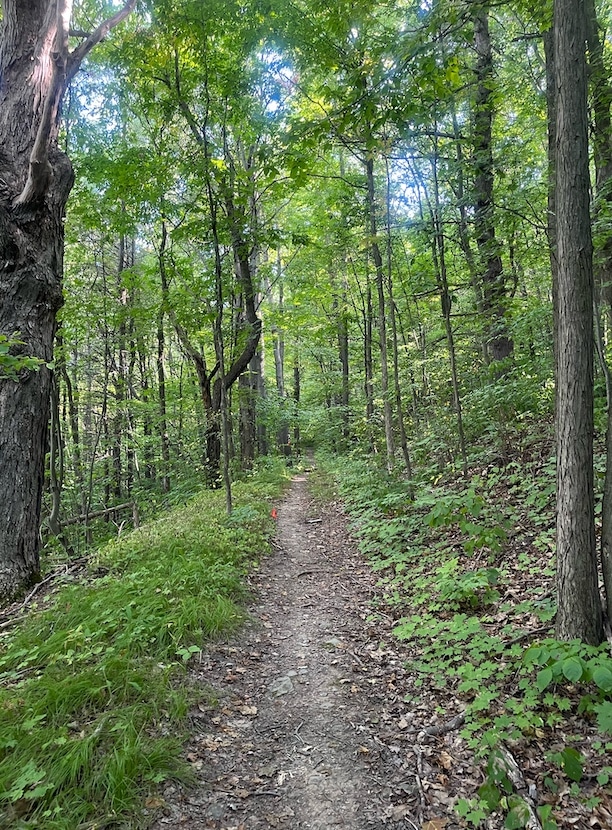
Curveballs and a Forced Pivot: A Surprise Injury: After my family and I returned home, I took just one day to get caught up at home (read: unpack and do ALL the laundry) before heading out for my long run to prepare for the 45 miles at Many on the Genny in late July. And that’s when it happened. As I was leaping over a creek I’ve jumped hundreds of times, I felt a pop in my left calf, followed by a dull ache. Though I was able to continue running and get home, my original scheduled 20-mile workout that I shortened to 18 miles due to fatigue would now have to be 16 miles. The uphills gradually became more difficult to run as I made my way around the trails once more, and I found myself having to walk most of them. Yet as I began to reflect, I realized I wasn’t thinking so much about my calf, but rather how exhausted I was…how I never had any energy anymore…how every time I walked up the stairs, even on rest days, I had to catch my breath while my legs burned. Perhaps I should not have run those remaining miles, but in those miles I gained a sudden and profound sense of clarity. Before I left those woods that day, I knew I would have to pivot significantly in the coming weeks. Less elevation gain. More easy running. Changing back to a lower-drop shoe. More recovery. There would be a significant step change to come in the second part of my season, starting with withdrawing from Many on the Genny.
I made the decision to take five rest days and revisited the chapters in my books on Overtraining Syndrome (OTS). While I managed to avoid full blown OTS, for months I had been experiencing symptoms that were worth noting, including night sweats, irregular menstrual cycles, irritability, insomnia, mental burnout, intense leg fatigue (especially after climbing the stairs in my house) and now, injury. During my recovery days I was able to think a little more about how I had been feeling as a whole, and I realized that some of my previously favorite steep workouts were beginning to deter me. I love the climb but I was losing my enthusiasm for it.
I also researched everything I could on calf strains. With improvement occurring even after the first couple of days, I opted not to visit my ortho, and based on my symptoms it was likely a Grade 1 strain of the head of the gastrocnemius muscle in my left leg. There was no bruising, I was able to walk, and I could always support my body weight on the one leg. I took ibuprofen for the first three days to help with discomfort and inflammation and massaged CBD balm into my calf muscle. I invested in a pair of medical grade compression calf sleeves. I would wear a sleeve on my left calf daily for the first two and a half weeks, and after that, just for every workout.
After the pause, I gradually resumed running, avoiding the big hills until my calf was more recovered. And I would first return to the roads, in an effort to mix the elevation gain between the trails and asphalt, so I could bring the overall vertical down just a bit. It turns out my summer trails are pretty steep. Following two weeks of tempered running, my calf strain began to turn a corner. Still, rather than jump right into my previous style of training and just run all the hills I wanted, I calculated the elevation gain for Twisted Branch, and focused my training on preparing specifically for that. I didn’t have to train at 200+ ft/mile of elevation gain anymore. By the end of July, I began to write out a training plan for the remaining three weeks leading up to the race, including two weeks of back-to-back runs and a final week of tapering.
My Mother’s Burial: In the midst of pivoting and managing an injury, on August 1, my mother would be buried next to my father at Arlington National Cemetery, after two years of waiting. Grieving my late mother has occurred in stages (death, cremation, estate sale, house sale, burial), but even in this final stage, I could feel the weight of her loss and the finality of this entire process. The estate sale last year so profoundly affected my perspective on life and things, that I gave away 75% of my own personal belongings and wrote an article chronicling everything.
My Husband’s Travel and Covid: To be honest, the idea of this trip had been causing me heartburn since my husband first planned it in the spring. He would travel during the first week of August, which in my mind was perfect timing for him to return home, become sick with anything he caught at a convention with more than 70,000 participants, and then pass it on to me, just in time for race week. I decided to manage my anxiety by imposing a self-quarantine: the night he returned to town, I moved myself into the guest room and would remain there for several nights. I’d use the girls’ bathroom to shower. I was sure I was overreacting but…one can never be too sure right?
Three days later, my husband tested positive for Covid.
He had managed to avoid it for three years…until now.
And after a two-day break from solo parenting, I was right back at it again.
The next two weeks would be a whirlwind of long back-to-back training runs, drop offs and pick ups from summer camp, attending end-of-camp talent shows and activities, cooking all the meals and delivering them to the bedroom or patio, washing and putting away all the dishes. Then there was laundry, grocery shopping, feeding the fish, feeding the birds…the hummingbird feeder…other miscellaneous errands… I’d fall into bed at night so exhausted and wound up, I couldn’t sleep. And I’d rise in the morning to start all over again. Somehow I still managed to shower but a few times I couldn’t find time to eat. I had moments in which I was tired, angry, frustrated, and afraid. I needed my daughters to see me maintain my composure during this uncertain time, but I was pressed right up against my breaking point. A few times I stepped into another room to cry in private. Major kudos to all single parents out there, for whom solo parenting is a daily reality.
(Note: the girls and I remained healthy throughout this time.)
Yet however narrow that tunnel to race day became, the light at the end of it was still there. And so I chose to focus on the light. In the second week of my revised training plan, I managed to complete my 20 mile run on the same day my husband first tested positive (he texted me to tell me while I was on the trails), though it meant only having time to chug some Tailwind Recovery and squeezing in a 10 minute shower before having to pick up the girls from camp. And sanitizing the entire house. The next day my scheduled run was only about 10 miles but I had to get to camp two hours sooner for the girls’ talent show. And I needed to make sure my quarantining husband didn’t starve so before I left, I also needed to deliver lunch. Still… there was no longer any discomfort in my left calf. I was completing my workouts. The girls and I were healthy. I had made it this far, so I wasn’t going to quit now, after having waited for almost a full year for the opportunity to toe the line at Twisted Branch once more.
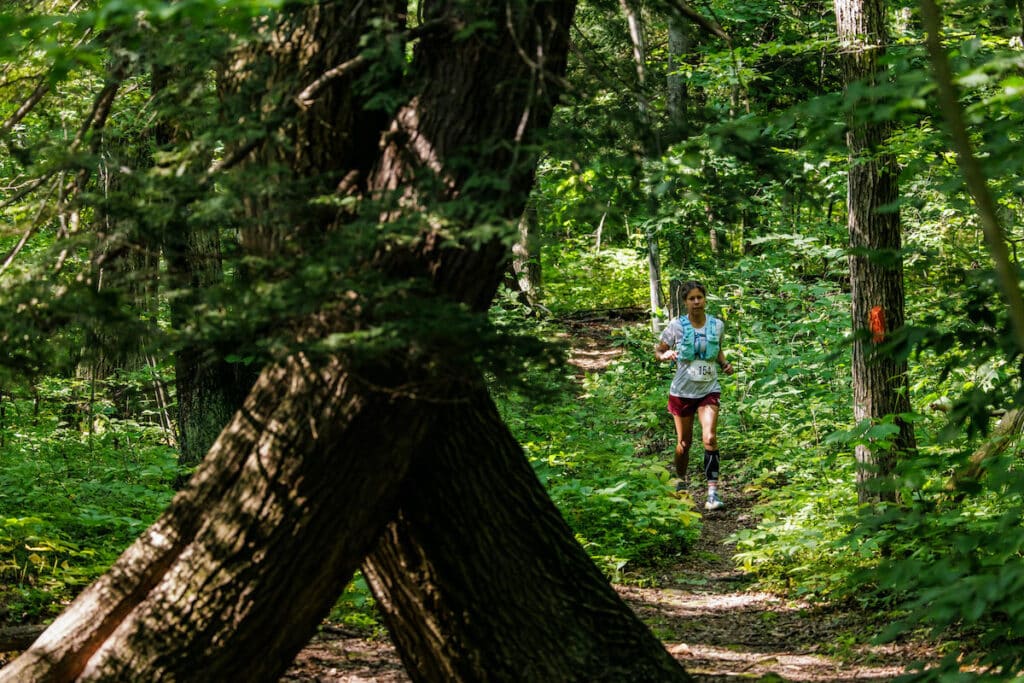
Taper Week, Sort Of: Recalling the lessons learned in 2022 about not tapering in all areas of my life, I worried about this taper week. Sitting with my feet up and taking it easy would instead be replaced by rushing through long task-filled days and eating when I could. Having recently learned that cortisol released into your body from stress appears the same to your body, regardless of whether those stresses originate from life or from training, and in an effort to mitigate this as well as I could, I opted for additional rest days, running only twice during this taper period. In the end, I believe this made a significant difference for me. What also made a significant difference was my husband’s recovery. Race day would be Day 10 for him, so though he continued to quarantine, subsequent Covid tests were showing less infection.
I never really felt nervous as the days passed and race day slowly approached. By Friday I already had the car partially packed, and was able to manage a few last-minute errands and gas up, before cleaning the rest of the dishes, finishing loading the car, and heading for Hammondsport. But before I left, my daughters and I devised a plan. My husband would emerge (masked) only to take his meals on the patio outside. The girls handled the cooking, with my oldest daughter making pizzas on Friday night, and croissants on Saturday morning, bringing meals upstairs or outside to the back patio when my husband ate outside. Both girls cleaned the dishes, put them away, and loaded the dishwasher. They even helped pick up the crafts from the living room floor, which was most unusual. I promised them payment as a thank you, as I was asking them to step up into a bigger role for a day. My plan was to leave Friday afternoon, be gone all day and evening on Saturday, then drive home Saturday night after the race. Knowing everything would be under control while I was gone, and that it was okay to let go a little, made it easier for me to leave home.
I enjoyed the drive to Naples and arrived early, so I had a few minutes to meet some of the other participants before we loaded the shuttle buses. In fact, the only hiccup of the evening was that I arrived at the start line area in shorts, last year’s Twisted Branch t-shirt, and Birkenstocks, only to find driving rain and endless wind. Not only was setting up my tent incredibly difficult (another runner came over to help me), I ended up soaked and shivering in my tent. So I made the decision to forgo the evening race briefing, in an effort to get warm and dry. I ate my cold leftover pizza in my tent and then went to sleep. The night would continue to offer plenty of wind, as I awoke a few times to my tent wall blowing against my head. But I was warm and I was there and that was all that mattered.
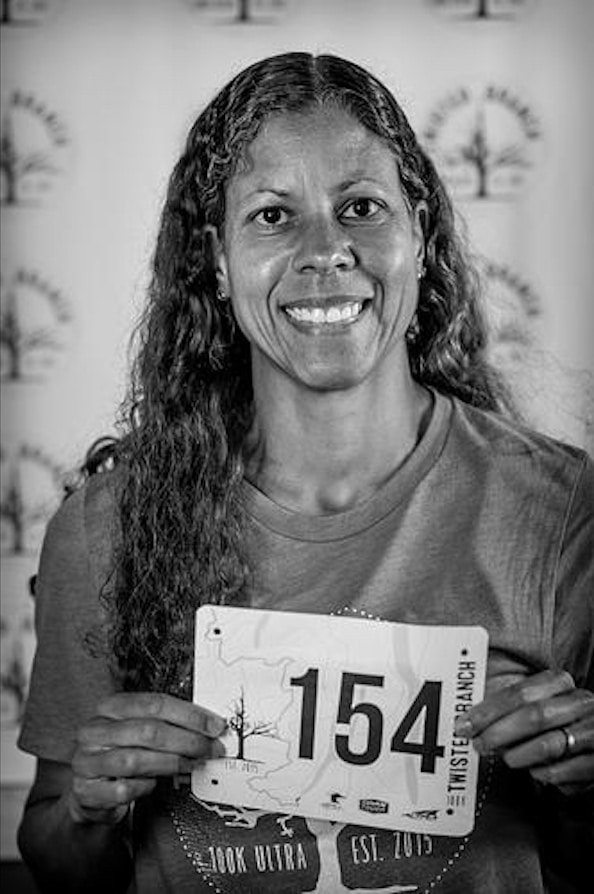
August 20, 2023: The Big Dance, Take 2: When my alarm went off at 3:00 am, I calmly got dressed and put together my gear and tent. I delivered everything to the U-Haul and then completed my second check-in for the race. This was it. And as I headed to the start line, everything felt so familiar. I had been here before and it felt like only yesterday. The plan today was to run well through Bud Valley, make that cutoff, and finally continue on to see the rest of the course. I had waited for this opportunity for an entire year.
But given the preceding three weeks and months, I fully intended to show myself grace on this day and not place any additional pressure on myself, other than just finishing under the 20 hour cutoff. That would be good enough to secure a finish and to earn my first-ever ticket for the Western States lottery. I would respect my body, given the task at hand and the sprained ankle, Achilles tendinosis, sore glutes, calf strain, overtraining, my mother’s burial, and husband’s Covid that I had somehow managed to work through. I was well aware that mental fatigue could find me once again. My primary focus would be how to manage it, if it did.
After just a few pre-race announcements, we were off into the woods. And everything was again familiar. Like last year, the pre-dawn trail running was a wonderful adventure, as I found myself in a line of runners and stream of headlamps following singletrack through the woods in the dark. There was so much camaraderie. Everyone was in such a great mood, even at 4:00 in the morning. When I arrived at the Cutler aid station (6.0 mi), I still had plenty of fluids and so I kept right on going. And what was immediately apparent was how much more I could open up on the roads than I could last year. I ran a good pace for a couple of miles with my new friend Kim before we returned to singletrack; this made me feel really confident that today would go differently than last year. Kim and I would continue leapfrogging throughout the day, until we reached the Lake David aid station in the afternoon, at which time I would connect with two other runners.
At the Naples Creek aid station (12.5 mi), I still had plenty of fluids, so I again continued running. When I reached the Sneaker aid station (18.2 mi), I saw my friend Marie and gave her a hug. Still having enough fluids on me, I again continued. I remembered this climb from last year and felt prepared for this very vertical wall of single track. I did climb conservatively, however, taking numerous 2-3 second pauses to assure my left calf could handle the climb and continue to feel good after I crested the hill, which it did. I was able to make it to Italy Valley (22.6 mi) before needing to refill my soft flasks, which I did quickly before departing. The day seemed to be moving along and I was running well. When I reached The Lab (29.3 mi), I again saw Marie and my friend Clement, and gave him a hug. I was grateful for all their words of encouragement and after a quick porta potty stop, I continued on. But upon reaching the Patch (35.6 mi), I felt the mental fatigue slowly beginning to creep in. I wanted something other than Tailwind and was craving cold, fresh water, so I refilled my flasks with only that. It tasted delicious and I enjoyed the cold water as I eagerly ran toward Bud Valley.
And I would arrive at the Bud Valley aid station (39.8 mi) nearly 2.5 hours sooner than I had last year! Both Marie and Clement were there and cheered me on for making the cutoff here this year. With no pressing need for additional fluids, I was very happy to run on through. Looking back, however, I probably should have refilled at least one flask there. By the time I reached the Glenbrook aid station (46.2 mi), I was low on fluids and starting to get a headache, likely from the lack of electrolytes, so there, I refilled my flasks and mixed one with Tailwind. I was feeling a little tired but I had made such good time. One of the volunteers informed me that I had three hours to get five or so miles to the next aid station; he said I could walk a little and still have plenty of time, which felt amazing. The mental fatigue was slowly enveloping me but I told myself I would “do at least 50 miles on this course,” so I marched/ran myself to the next aid station.
At the Lake David aid station (50.6 mi), I had a quick porta potty stop, refilled my soft flasks and continued with the “one Tailwind/one water” approach. At this point, the mental fatigue was really starting to kick in and I daydreamed about calling it at 50 miles, at such a beautiful aid station on such a beautiful, sunny afternoon. And I began dreading a run in the darkness alone, which is so uncharacteristic of me. It was then that I noticed the runner and pacer I had leapfrogged with for many miles and made the spontaneous decision to ask if I could officially tag along with them. Enter: Kacey and Stacy. This decision would be an absolute game changer for me, as they would not only make the hours to come so much more fun, I would form two new friendships in the process. We would soon begin the game of making it from one aid station to another, but running with my new friends made it so much better as I gradually began to feel worse.
After getting to know each other, Stacy thought of a long story to tell us, and since we had plenty of time, she told us a great story that would last several miles, ending right before we reached the Mitchellsville aid station (55.7 mi). We laughed about so many things. And one of my favorite moments of the race would happen as we shuffled toward the Mitchellsville volunteers and Kacie flatly announced “Look out, we’re coming in hot.” As tired as I was, in this moment, I found the energy to laugh. I still laugh as I write this. It really is the little things. (That one’s for Stacy.) At the Mitchellsville aid station, I refilled my soft flasks and began to feel unsure about going another 10-ish miles. But Kacey and Stacy assured me “We’ll get you to the finish line” and Marie was there to assure me that I absolutely could. At this point, my stomach was not quite right but I figured it would be only a couple of miles to the next aid station, so I could reassess there. Once we refilled, the headlamps came out and we were ready for the sun to set. Less than 10 miles to go now.
Reaching the Urbana aid station (59.2 mi) in total darkness felt absolutely surreal, realizing that all we had left was climbing and descending Mount Washington. “First you go up, then you go down” became our mantra. Though my left calf was managing well, my right calf and right foot arch had started to ache. My stomach still wasn’t quite right, but we would take it easy on the uphills to accommodate my right calf and on the downhills to accommodate Kacey’s quads, which helped. An easy pace and less talking from me made it all manageable, though I was starting to think that all the stomach growling might have been the result of actually being hungry. I recalled that I only had two small slices of cold pizza for dinner the night before, a handful of dry cereal before packing up my tent at 3:00 am, Tailwind Endurance calories and two watermelon wedges throughout the day, and then there were the 17 hours of running…of course my body was hungry. But we passed the time and managed the discomfort by laughing about the millipedes on the trees, having to climb over tree trunks with bodies too stiff to bend, and discussing “mudslides” and Taylor Swift songs, with me randomly saying something about popping “out of the woods” as we were descending Mount Washington on our way to the finish. For me, that Taylor Swift song would become the theme for my race that day.
Everything felt even more surreal as we emerged out of the woods to the sounds of cowbells in the distance, with the lake and lighted finishers arch coming into view. “Oh my goodness, look!” I spun around and pointed to show Kacey, who was behind me, as soon as I saw the arch. The mental fatigue late in the day had been relentless in its pursuit of me (was I really going to drop at 50 miles?), but with all the laughs and encouragement from Kacey and Stacy, I did cross that finish line. And not only did I finish, I was able to share my longest run to date with my two new friends.
On this day, my Garmin read 65.8 miles and 10,833 ft of elevation gain.
In the end, 191 runners toed the line and 158 finished. This year I was one of them. After 19 hrs 25 min and 29 sec, I was out of the woods. The 2023 Twisted Branch 100K results can be found here.
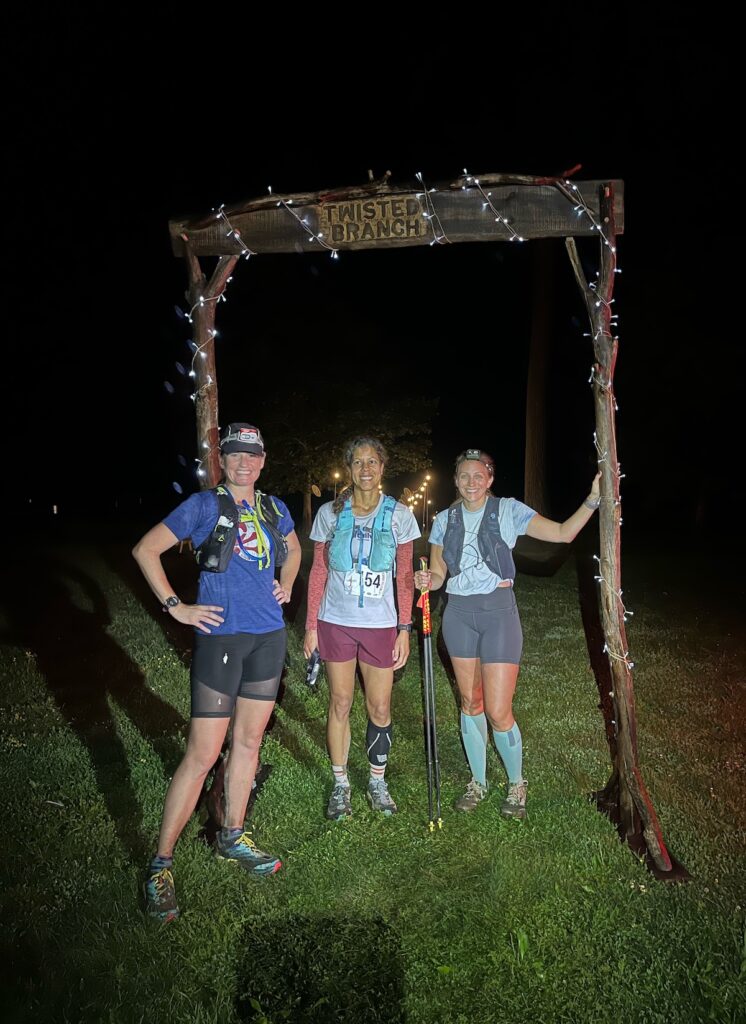
About the Author

Kuwanna has a PhD in geology and is a UESCA-certified Ultra Run Coach. She is married with two daughters and feels that running all the miles is a great panacea for helping navigate those teenage years. Kuwanna has a love for tough, vertical trail marathons and ultras, with several Beast Coast races under her belt, including Virgil Crest, Cayuga Trails, Hyner View Trail Challenge, and Breakneck Point Trail Runs. Having now completed several 50Ks, 50-milers, and a 100K, she’s eyeing her first 100-miler. When Kuwanna’s not running on the trails, she’s writing about it. She is co-editor/writer at the Trails Collective and has created content for the Patagonia Trail Running IG. She also serves on the Finger Lakes Runner’s Club Communications Team. Instagram handle is @dyerpietras.
Share This Article!












